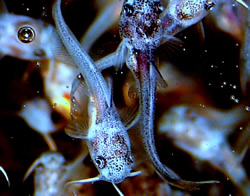To support this important industry, scientists with the Agricultural Research Service (ARS) are investigating how breeding programs and management practices can promote catfish health. ARS is the principal intramural scientific research agency of the U.S. Department of Agriculture.
At the ARS Catfish Genetics Research Unit in Stoneville, Miss., scientists are examining the role of genetics, nutrition and production practices on catfish health and production economics, and their work has had major benefits for catfish, the industry and consumers. Stoneville is the primary ARS location emphasizing research on catfish.
Banking on Genes
Selective breeding is a crucial element of any program to improve commercially important genetic traits, and tools such as genome maps can be indispensible to these efforts. Stoneville scientists, led by molecular biologists Geoff Waldbieser and Sylvie Quiniou, have constructed the first genetic and physical maps for the channel catfish genome. These maps will assist genomic studies of catfish.
"One of the Catfish Genetic Research Unit's goals is to breed catfish with increased resistance to disease," Quiniou says. "And one of the major pathogens we're focusing on is Edwardsiella ictaluri, which causes enteric septicemia of catfish."
Quiniou has been working with her colleagues to identify genomic regions associated with resistance to E. ictaluri. At Stoneville, physiologist Brian Peterson and microbiologist Natha Booth have identified fish with varying degrees of resistance to the pathogen, which Quiniou is examining for genetic regions related to resistance or susceptibility, known as quantitative trait loci, or QTLs. Markers from the genetic map will assist in identifying QTLs.
"QTLs only identify large genome regions," Quiniou says. "The physical maps will enable studies of those larger regions and fine mapping of the genes responsible for specific traits."
With the maps developed at Stoneville, Quiniou and her colleagues should be able to gather information that could help them develop genetic markers associated with improved resistance to E. ictaluri and other desirable production traits. These markers could be used to assist breeding efforts for channel catfish.
Take a Deep Breath

After breeding, the next step of the process is hatching and raising the young fish, or "fry," in commercial hatcheries until they're large enough to be transferred to ponds. Proper management at this stage can mean the difference between average and superior yields for producers. So what can they do to increase survival?
Catfish eggs need oxygen and plenty of it, particularly during the last day of incubation. That’s the conclusion of fish biologist Eugene L. “Les” Torrans, who found that insufficient oxygen in hatcheries could reduce hatch and survival rates in catfish by as much as 20 percent.
Torrans collaborated on this work with Jim Steeby, an Extension aquaculture specialist at Mississippi State University. Together, Torrans and Steeby have more than 70 years' experience with the catfish industry. The two also determined that more than 65 percent of hatcheries in Mississippi and Arkansas had lower-than-optimal oxygen rates during the critical high-oxygen demand period.
Torrans and Steeby identified potential solutions to the problem, such as using liquid oxygen to ensure that catfish hatcheries provide enough oxygen to the eggs. In 2008, they received technology transfer awards from ARS and the Federal Laboratory Consortium for sharing this technology with the catfish industry. The two have spread the word about the need for increased egg oxygenation throughout the industry. And they’ve worked directly with 12 fish farms in Mississippi and Arkansas to adopt improved management techniques.
To date, more than 75 percent of the region's catfish hatcheries have adopted the technology, leading to an estimated $1 million increase in annual revenue for the catfish industry.
Fish Fitness
Nutrition is another essential element of channel catfish health, so scientists at Stoneville have been examining the benefits of supplementing catfish feed with prebiotics, non-digestible substances that promote the growth of naturally occurring bacteria within the digestive system.
In one ARS study, Peterson collaborated with Mississippi State University chemist Bruce Manning to add a prebiotic called mannan oligosaccharide to commercially available catfish feed.
"We didn't see any significant improvement in weight gain or feed efficiency," Peterson says. "But the fish were more resistant to the bacteria that cause enteric septicemia of catfish." In Peterson's studies, fish that had been raised on prebiotic-supplemented feed showed greater resistance to this disease, one of the most significant threats to the U.S. catfish industry. In some cases, the fish were as much as 30 percent more likely to survive exposure to the bacteria than fish in a control group.
These studies were conducted in laboratory tanks. But most farm-raised fish in the United States live in outdoor ponds, where fish are more likely to encounter bacteria and viruses. Peterson and his colleagues plan to repeat the studies in a pond environment. A positive response there would indicate that mannan oligosaccharide could be a beneficial supplement for catfish feeds.
Around the country, research programs like these support U.S. aquaculture by providing the information and guidance needed to raise a large, healthy, well-managed population of catfish. unknown.




